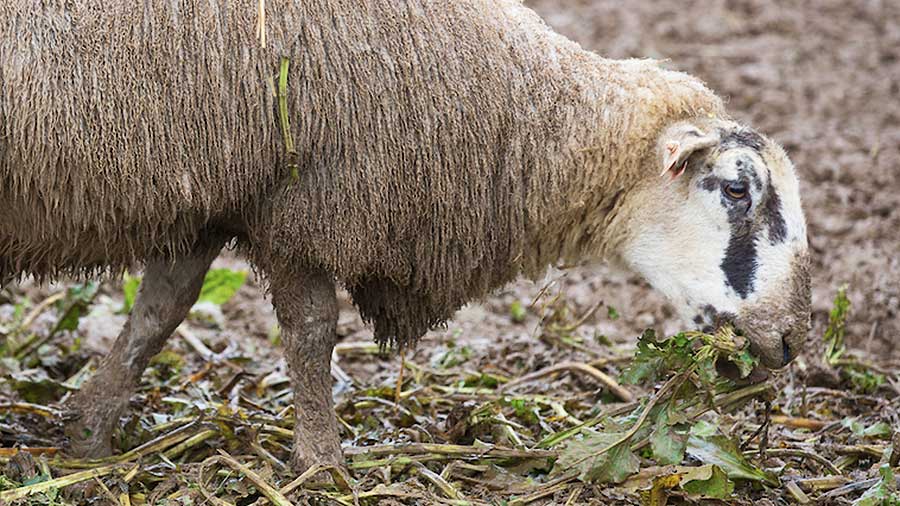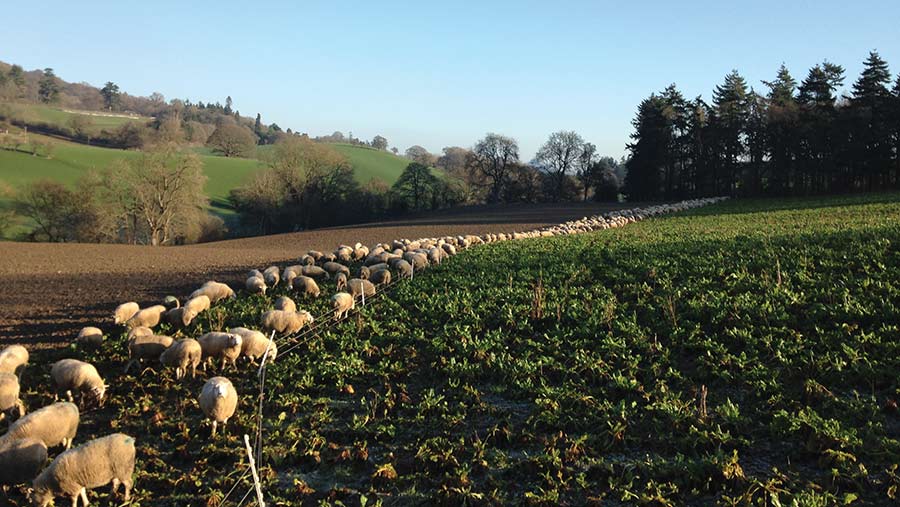Fodder beet feeding advice for ewes and lambs
 © Tim Scrivener
© Tim Scrivener Ewe lambs and yearlings can eat more than 3% of their liveweight a day in fodder beet. But to reach this intake and achieve good liveweight growth the crop must have good leaf cover and be correctly allocated.
Jim Gibbs, a veterinarian and research scientist, has spent 10 years working on the merits of fodder beet for livestock and seen the hectarage in New Zealand expand from 10ha to 70,000ha (25 acres to 173,000 acres).
Dr Gibbs said the high-energy, high-yielding crop could be a cost-effective feed option for sheep systems.
“Fodder beet is, by far, the highest-energy forage crop available to us,” he said. “And as a general rule of thumb, whenever you have a big crop, it’s a cheap crop, and that’s what’s driven its popularity in New Zealand.”
Dr Gibbs shares his advice on using the crop for wintering sheep and finishing lambs.
See also: Video – advice for feeding fodder beet to dairy cattle
Crop specifications
- High yields 20t-plus dry matter (DM)/ha
- High metabolisable energy (ME) 12MJ/kg DM
- Low cost 5-8p/kg DM (UK calculation)
- Leaf nutrition protein and minerals
- Bulb nutrition energy (sugar)
Ewe wintering
Fodder beet is a safe and productive feed for multiple-bearing ewes, which can be stocked at high rates.
The high yields allow stocking rates of about 100 ewes a ha for 100 days (based on a 20t DM crop), resting grazing ground for lambing time and restricting winter ground damage to a smaller area.
Paddock design can be kept simple without the need for headland areas set aside, which is a requirement when grazing cattle on fodder beet. To minimise the issue of bullying, a linear feed face should be allocated at a ratio of 1m for every three to four ewes.
The high ME, low-fibre feed provides enough metabolisable protein for the ewe in a well-managed crop, so supplement requirement should be nil to minimal (100g/day or 100g every two days).
At such dense stocking rates, it can be difficult to supplement with forage and provide access to all ewes. However, ewes can be co-grazed on grass – by walking them on to grass to graze for a period then back on to the crop.
Including 100g DM of supplementary feed to ewes, either daily or every other day, can marginally increase beet intakes.
Fodder beet can be grazed in multiple day breaks but it should not be pushed beyond three days. Breaks longer than this can lead to the sheep eating all of the leaf and then having several days of eating the root alone.
With the lack of protein from the leaf, sheep are unable to utilise the energy in the root and this leads to metabolic disorders such as twin lamb disease (see “Allocation” below for more information).
Hogget and ewe lamb wintering
For younger sheep, it is almost always a requirement to provide a supplementary feed every day, typically 100g DM.
Ideally fodder beet should be co-grazed with pasture or, where this is not possible, good quality silage should be offered.

© Marc Jones
Ewe lambs can be stocked at 130 lambs a hectare (2.47 acres) on the fodder beet for 100 days with 1ha of grass to provide the extra 100g of grass every day, based on entry at 2,500kg DM/ha and exit at 1,200kg DM/ha. This means 1ha of beet and 1ha of grass would keep 130 ewes lambs for 100 days.
With a 25% leaf proportion, very high intakes can be easily achieved. However, you cannot supplement to replace the leaf, so agronomy is critical to avoid a poor leaf crop. The leaf provides the protein and the bulb provides energy, and they must be grazed together.
It is difficult to supply the protein in supplementary feed without the fibre content getting in the way and impeding intakes.
Therefore, the planning and management of the crop is more important with younger sheep, as is the variety choice. Some varieties are leafier and more palatable than others, so target these.
Lamb finishing
Fodder beet is not suitable for finishing lambs because, unlike cattle, its crude protein level is too low to achieve the required liveweight gains. And supplementation alongside fodder beet would be too expensive. But it can be used as a “holding tank”.
It is possible to achieve 100g/day of liveweight gain grazing at very high stocking rates (double that of sheep – 200 lambs/ha for 100 days) and to pull the lambs off the fodder beet in groups to finish on a suitable high crude protein diet.
An effective alternative for lamb finishing is to lift the beet, scatter it on to pasture, and strip graze the grass and beet.
The beet then makes up about 50% of the diet, which will allow the stocking rate to be doubled at grass. Based on entry grass covers of 2,500kg DM/ha, stocking levels can be pushed to 22 lambs a hectare for the 56 days required to finish the lambs from 30kg to 45kg.
Allocation
Allocation is trickier with sheep than cattle because they don’t lift the beet out of the ground and they don’t “clean up”. It is imperative to have a good idea of yield and what is being allocated over time, because too much or too little will cause diet imbalances and reduce intakes.
Over-allocation This will result in sheep eating more of the protein-rich leaf than the energy-dense bulb, leading to sub-optimal energy intakes and potential health issues such as ketosis and twin lamb disease.
Under-allocation This must also be avoided. It can be tempting to under-allocate to force the sheep to clear up the bulbs, but in this situation, with no solid protein to eat with the bulb, intakes will crash. This will lead to smaller, weaker lambs at lambing time.
Health considerations
- All classes of sheep must be fully vaccinated for clostridial diseases before they are turned on to the crop. Losses can be significant if sheep are not properly vaccinated.
- Trace element supplementation – copper and selenium in particular – will depend on naturally occurring levels for the region – local veterinary advice is needed on this.
- It is very rare for sheep to succumb to acidosis on fodder beet because they regulate their intakes better than cattle. Therefore, they only require running on and off the crop for three or four days at the start of grazing.
